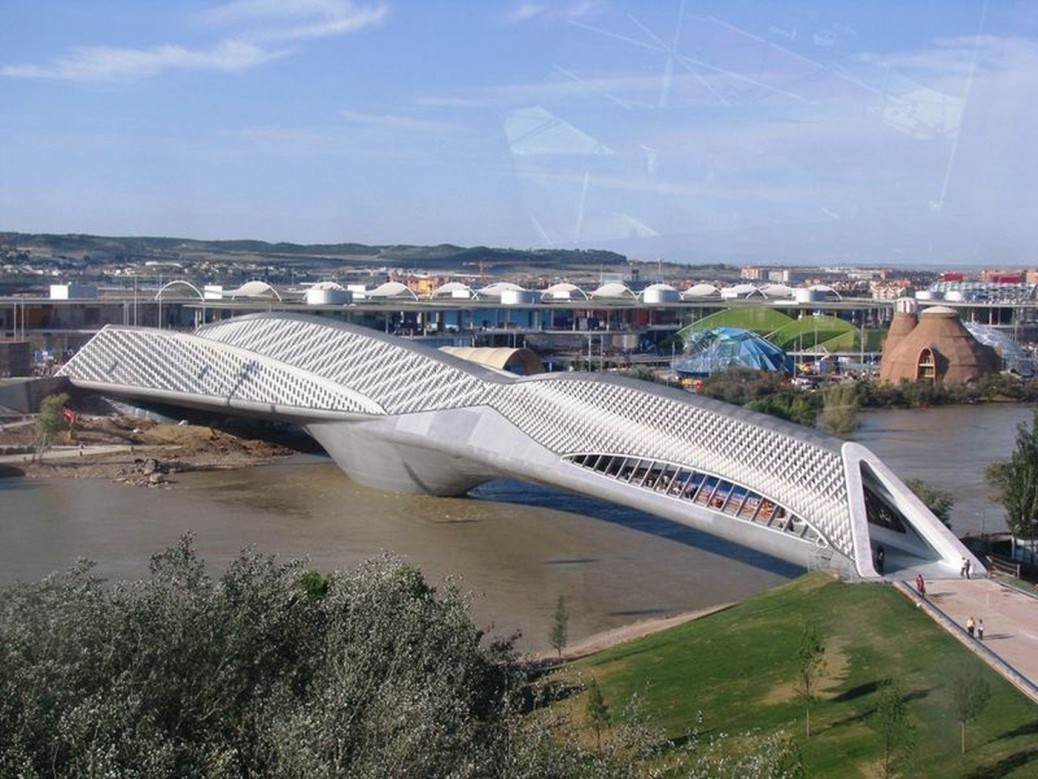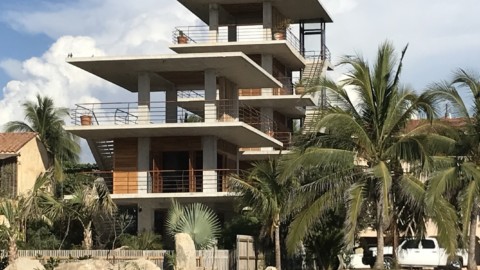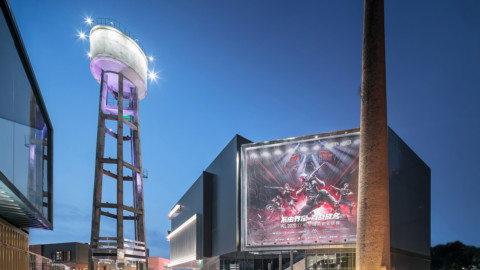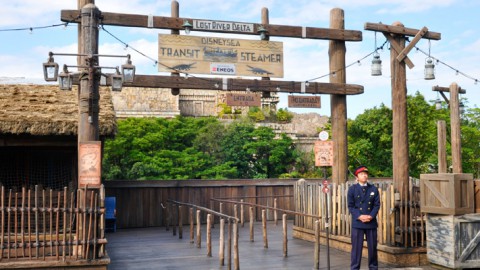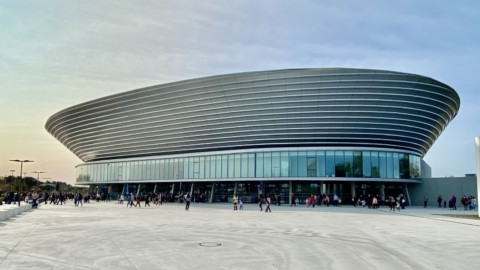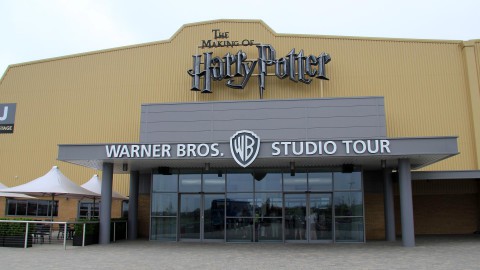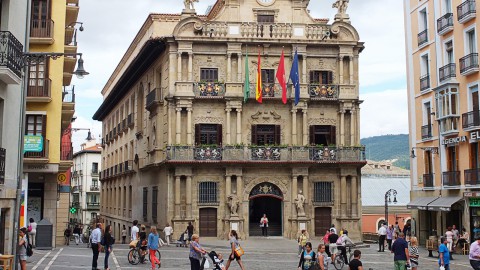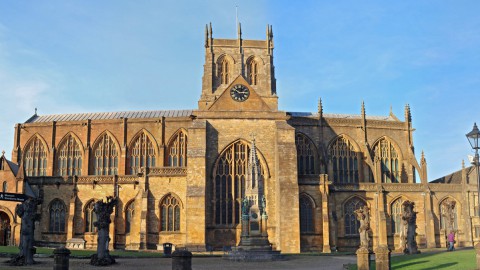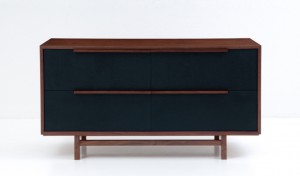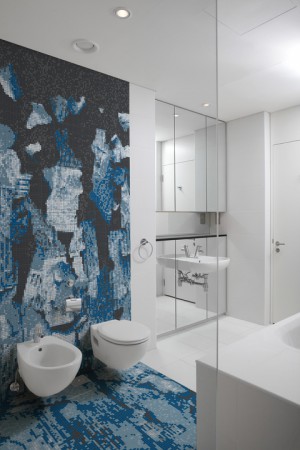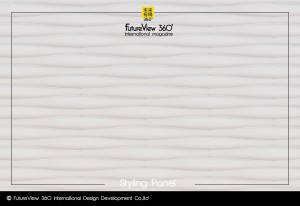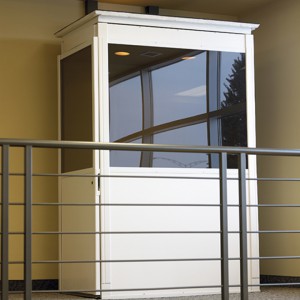Bridge Pavilion
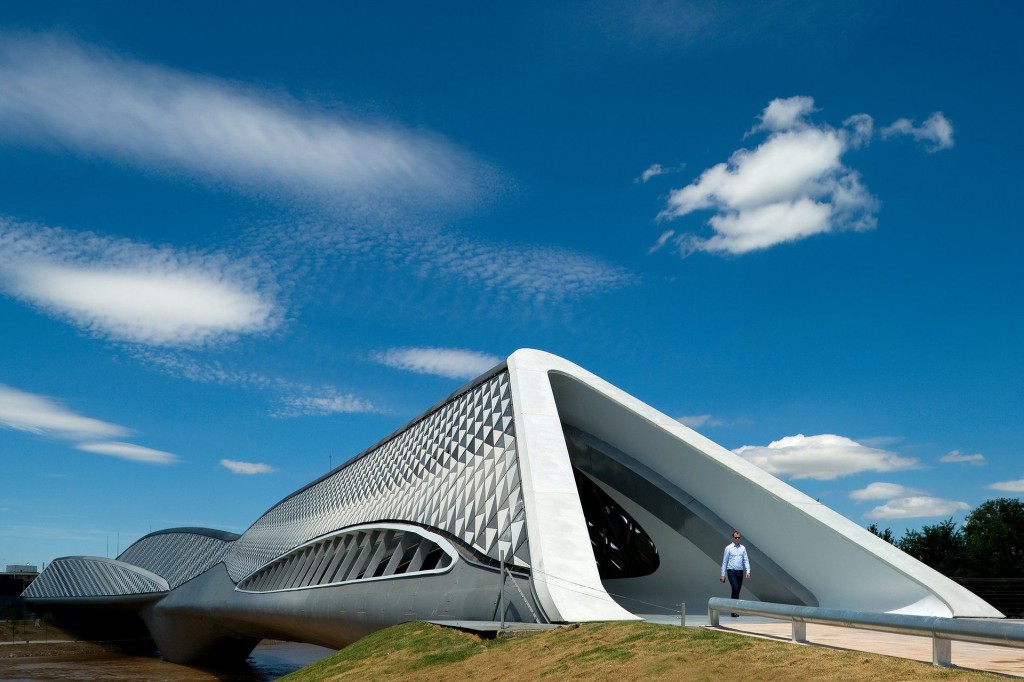
The Bridge Pavilion (Spanish: Pabellón Puente) is a building designed by British-Iraqi architect Zaha Hadid that was constructed for the Expo 2008 in Zaragoza (Spain) as one of its main landmarks. It is an innovative 280-metre-long (919 ft) covered bridge that imitates a gladiola over the river Ebro, connecting the neighbourhood of La Almozara with the exposition site, and thus becoming its main entrance. The new bridge is, at the same time, a multi-level exhibition area; 10,000 visitors per hour were expected to frequent the Pavilion during world exhibition.
Hadid chose fibre glass reinforced concrete from Austrian company Rieder to envelope the bridge: she covered the outer skin of the building with 29,000 triangles of fibreC in different shades of grey.
During the Expo 2008, the Bridge Pavilion hosted an exposition called Water – a unique resource, designed by Ralph Appelbaum Associates. When the Expo was over, the building was purchased by the local savings bank Ibercaja to use it as a site for expositions.
Bridge Pavilion(西班牙語:PabellónPuente)是由英國 – 伊拉克建築師扎哈·哈迪德(Zaha Hadid)設計的建築,為西班牙薩拉戈薩(Zaragoza)2008年世博會建造,是其主要標誌性建築之一。這是一座創新的280米長(919英尺)的有蓋橋樑,模仿埃布羅河上的劍蘭,連接La Almozara街區和展覽場地,從而成為它的主要入口。新橋同時是一個多層次的展覽區;在世界展覽期間,預計每小時將有10,000名遊客參觀。
Hadid從奧地利公司Rieder那裡選擇玻璃纖維增強混凝土包圍橋樑:她用29,000個不同灰色陰影的三角形纖維覆蓋了建築物的外層。
在2008年世博會期間,Bridge Pavilion舉辦了一場名為Water的博覽會 – 由Ralph Appelbaum Associates設計的獨特資源。當世博會結束時,該建築被當地儲蓄銀行Ibercaja購買,並將其用作博覽會的場地。
The Bridge Pavilion is organized around 4 main elements, or “pods”, that perform both as structural elements and as spatial enclosures, where each “pod” corresponds to a specific exhibition space.
橋亭圍繞4個主要元素或“豆莢”組織,既作為結構元素又作為空間圍欄,其中每個“豆莢”對應於特定的展覽空間。
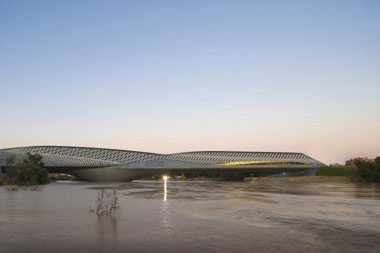
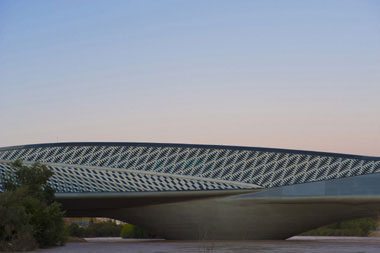
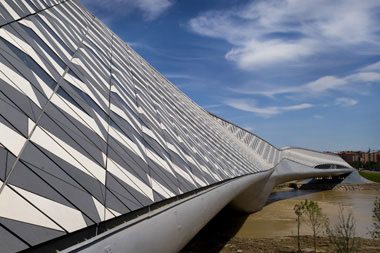
These pods intersect and brace each other, allowing the weight of the bridge to be distributed across the four trusses instead of a singular main element.
The body of the building evolves from the extrusion of a diamond-shaped section along a slightly curved path, projected diagonally across the shores of the Ebro River. Its dynamic shape is enveloped by a distinctive shark-scale skin, a permeable membrane that generates an internal microclimate based on the natural airflow. The concrete belly of the articulated volume partially rests on a small island in the middle of the river, reinforcing the hybrid, lifelike nature of its curvilinear volumes.
Located above the main flood level, the Bridge Pavilion connects with each river bank via a smooth inclined terrain. Each pod is located on the same level, except one which is 1.5 meters above this main level and intersects with its adjacent pods.
All pods are stacked according to precise criteria – aimed at reducing the Bridge Pavilion’s section as much as possible where the span is longer, and enlarging the section where the span is shorter. One long pod spans from the right riverbank to the island, where the other three are grafted into it, spanning from island to left bank.
This interlocking of the pods has given the design many exciting possibilities. Interiors become complex spaces, where visitors move from pod to pod through small in-between spaces that act as filters – or buffer zones. These zones diffuse the sound and visual experience from one exhibition space to the next, allowing for a clearer understanding of the content within each pod. The identity of each pod remains evident inside the pavilion, almost performing as a three-dimensional orientation device.
Each zone within the building has its own spatial identity. Their nature varies from completely enclosed interior spaces that focus on the exhibition, to open spaces with strong visual connections to the Ebro River and the Expo.
The envelope of the Bridge Pavilion encloses the exhibition spaces yet can be permeated by natural elements. The Bridge Pavilion’s internal micro-environment varies with the external climate and requires minimal cooling or heating infrastructure. A variety of openings convey and direct air into the building’s interior – cooling visitors in the heat of the summer.
這些吊艙相互交叉並相互支撐,允許橋樑的重量分佈在四個桁架上而不是單個主要元件上。
建築物的主體沿著略微彎曲的路徑從菱形截面的擠壓演變而來,沿著埃布羅河沿岸對角投射。它的動態形狀被獨特的鯊魚鱗片皮膚所包圍,這是一種滲透膜,可根據自然氣流產生內部微氣候。鉸接體積的混凝土腹部部分位於河中央的一個小島上,增強了其曲線體積的混合,逼真的性質。
Bridge Pavilion位於主要洪水位之上,通過平滑的傾斜地形與每個河岸相連。每個吊艙位於同一水平面上,除了一個位於該主水平面上方1.5米並與其相鄰吊艙相交的吊艙。
所有吊艙都按照精確的標准進行堆疊 – 旨在盡可能縮短跨度較大的橋亭部分,並擴大跨度較短的部分。一個長莢從右岸到達島嶼,其他三個嫁接到島上,從島嶼到左岸。
吊艙的這種互鎖為設計提供了許多令人興奮的可能性。室內設計變成了複雜的空間,遊客通過小型中間空間從一個空間移動到另一個空間,這些空間充當過濾器或緩衝區。這些區域將聲音和視覺體驗從一個展覽空間擴散到下一個展覽空間,從而更清楚地了解每個展區內的內容。每個吊艙的身份在展館內仍然很明顯,幾乎可以作為三維定位設備。
建築物內的每個區域都有自己的空間特徵。它們的性質從專注於展覽的完全封閉的室內空間到具有與埃布羅河和世博會的強烈視覺連接的開放空間。
Bridge Pavilion的圍牆圍繞著展覽空間,但可以被自然元素所滲透。 Bridge Pavilion的內部微環境因外部氣候而異,需要最少的冷卻或供暖基礎設施。各種開口將空氣輸送到建築物內部 – 在炎熱的夏季為遊客提供冷卻。
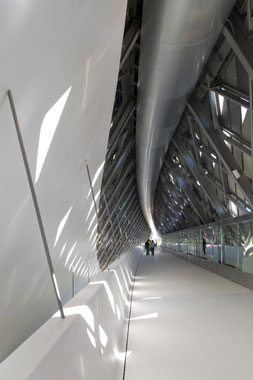
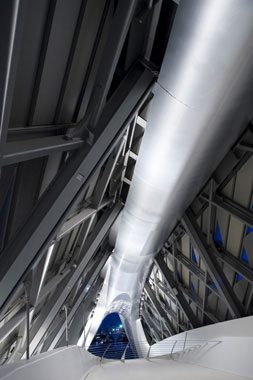
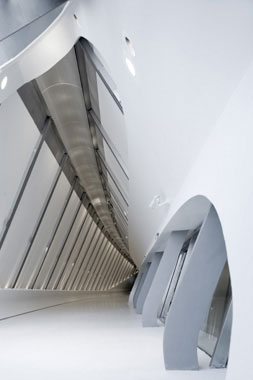
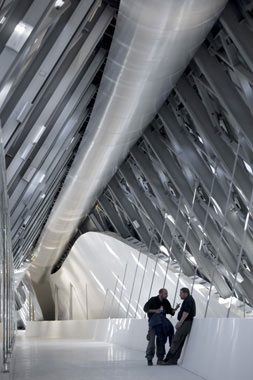
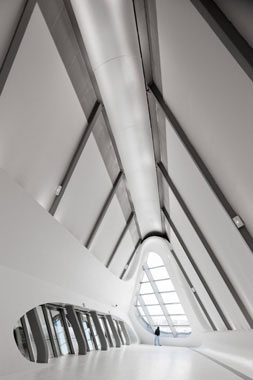
We designed an envelope for the Bridge Pavilion that encloses the exhibition spaces yet can be permeated by natural elements. The internal micro-environment varies with the external climate and requires minimal cooling or heating infrastructure. In particular, we considered the local Cierzo wind when designing the skin. A variety of openings convey and direct air into the building’s interior – cooling visitors in the heat of the summer.
/Zaha Hadid
我們為Bridge Pavilion設計了一個封閉展覽空間的信封,但可以透過自然元素。 內部微環境隨外部氣候而變化,需要最少的冷卻或加熱基礎設施。 特別是,我們在設計皮膚時考慮了當地的Cierzo風。 各種開口將空氣輸送到建築物內部 – 在炎熱的夏季為遊客提供冷卻。
/扎哈哈迪德
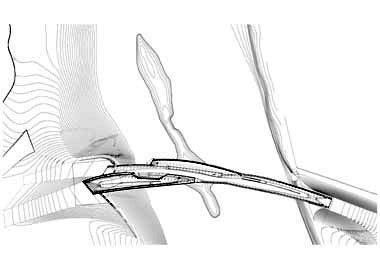
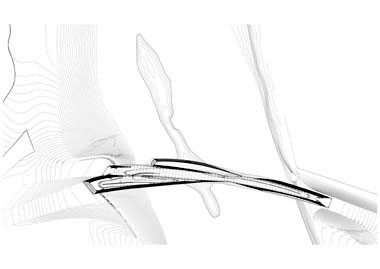
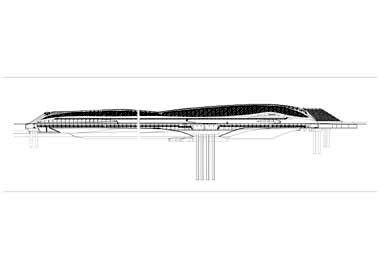
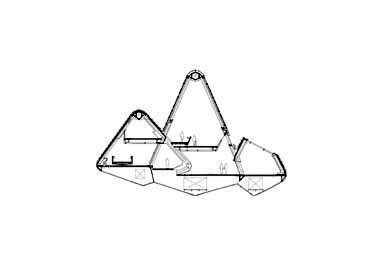
The design merges two traditionally distinct and separate building typologies: the “infrastructure” element (the bridge) and an “architectural” element (the pavilion). With the Bridge Pavilion design, Zaha Hadid Architects has challenged the conventional idea of a bridge being purely engineering.
該設計融合了兩種傳統上獨特且獨立的建築類型:“基礎設施”元素(橋樑)和“建築”元素(展館)。 憑藉Bridge Pavilion設計,Zaha Hadid Architects挑戰了傳統的橋樑純粹工程理念。
FROM:https://en.wikipedia.org/wiki/Bridge_Pavilion
https://arcspace.com/feature/zaragoza-bridge-pavilion/
FROM:bridge pavilion ZAHA HADID
FROM:Zaragoza Bridge Pavilion | Zaha Hadid | GSAPP
Don’t you think it’s addictive?
Want to know more about the beauty of architecture?
Come and join our members to explore the beauty of architectural design.
覺得看得不過癮嗎?
想要知道更多建築之美嗎?
快來加入我們的會員,一同探索建築設計之美。
The above article is purely for appreciation and sharing purposes, as well as the construction of new technology and the public can be in-depth understanding of the information at the same time there are sources, will be able to query, no use of the document as a commercial transaction, if illegal, please inform the We will immediately remove the site, thank you for cooperation.
以上文章純粹作為欣賞及分享用途,以及將建築新型技術傳遞給與大眾能夠深入了解,同時資料還有來源,將可查詢,絕無使用該文件資料作為商業交易行為,如有違法請務必告知該網站我們將立即處理撤除,謝謝合作。

